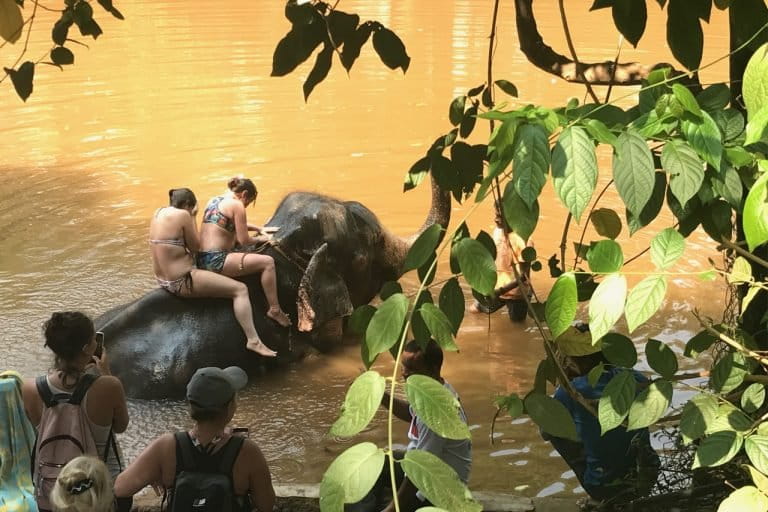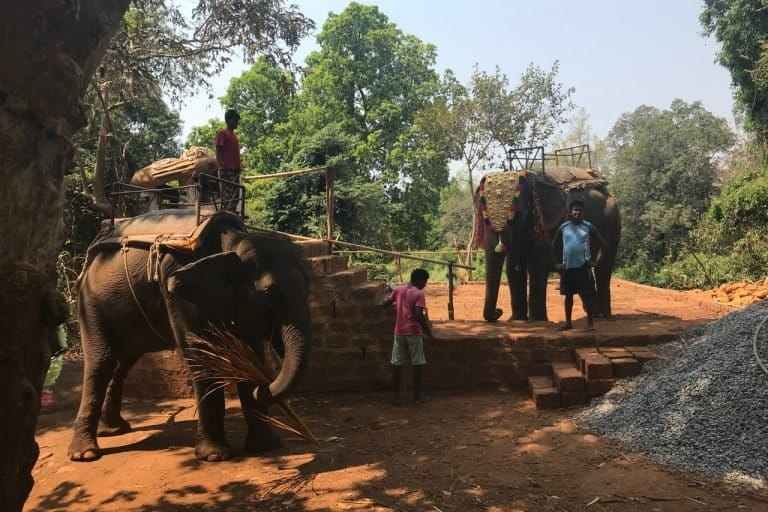- Performing elephants continue to be harassed in Goa’s resorts to put on a show for visiting tourists.
- This is happening despite strictures from the court and guidelines from the Central Zoo Authority.
- While elephant tourism is a ‘must do’ in many foreign and domestic tourists’ wish list, animal rights activists are trying to get protection for these performing animals.
Montora, a docile Indian elephant, enters the small, muddy brown lake. She rolls about, letting the water slide on her back. Her mahout shouts out to her in Bengali. His tone is sharp, commanding. She stops moving. Two young women enter the water and mount her back. The mahout stands in front of the elephant and gives sharp commands. Montora scoops water in her trunk and on command, lets it out on the women. They squeal in delight. Onlookers, mostly tourists from Russia and the United Kingdom, laugh and take pictures. Montora repeats the “power shower” several times on command.
Montora’s toenails are black, cracked and split with fissures. One nail is missing. There is heavy pink pigmentation on her trunk and ears and a small wound on her left ear. Her eyes are misty, with a continuous discharge. She wears a chain around her neck with a bell on it. She is 46 years old, docile and well mannered. Local staff say she works approximately 12 hours a day and on a “good day”, at least a 100 people visit.

Information obtained through the Right To Information (RTI) Act reveals that Montora travelled to Goa from Tinsukia district, Assam in 2007 on a journey that took about seven days in a truck. She has been with The Jungle Book resort ever since. Her caretakers say she can understand Hindi, Assamese and Bengali.
Montora is one of the five captive elephants at The Jungle Book, a large spice plantation resort in south Goa. The resort, in existence since 1987 (according to their brochure) conducts commercial elephant activities as a part of an “exotic, cultural experience”, catering to both international and domestic tourists. It has an “Elephant Village”, a large space covered with trees and canopies, narrow trails criss-crossing for “elephant rides”, concrete enclosures for elephants to sleep, a lake for elephant showers and huts for tourists to stay and enjoy interactions with the gentle giants.
Jungle Book is one of the four spice plantation resorts in Goa that regularly conducts commercial elephant activities for tourists. The other three, according to information retrieved through RTI, are Tropical Spice Plantation, Sahyadri Spice Farm and Sahakari Spice Farm.
As of 2016, there are a total of 12 captive elephants in Goa. All have been brought in from other states.
Elephant Tourism in Goa
Elephant tourism is popular business in Goa. Travel websites offer competitive packages, ranging from Rs 700 for an elephant shower to Rs 3800 for a full-day experience combined with a trip to the waterfalls and a tour of a spice farm. Online travel forums regularly feature discussions and reviews on elephant experiences in Goa. Locally, these tours are openly advertised, in brochures, pamphlets and through tour agents.
“Many tourists are attracted to these trips because it’s a must do experience,” said one visitor from the UK, who wished to stay anonymous.
“Go to India and ride an elephant! Many tourists just have a bucket list and tick these things off. They have absolutely no idea that the animals suffer,” she said.
One group of tourists visiting from the UK, emphasise that this is “vacation time” for the elephants. “The mahouts tell us that these elephants come in from Kerala, where they are made to work in the logging industry during the off-season,” said one tourist. “We are glad to see at least here they have the time to splash about in the water and take walks. I think we are doing them a service,” he said.
Meanwhile, online forums and social media platforms witness denunciations of such practices. In January 2016, following a global petition signed by 1,75,000 people, tour giant Thomas Cook stopped promoting elephant rides. This was followed by over 100 tour sites, including Trip Advisor and Lonely Planet banning elephant tourism. However, a media report from February 2018 that Thomas Cook is still promoting elephant riding tours at spice plantations in Goa.

The curious case of captive elephants
The Indian Elephant (Elephas Maximus) is protected under Schedule 1 of the Wildlife Protection Act, 1972. It is listed “Endangered” in the Red List of Threatened Species of the International Union for Conservation of Nature (IUCN). The population of wild elephants has reduced by at least 50 percent since the 1930s. The wild elephants today are scattered in the northwest, northeast, central and southern India.
The practice of capturing elephants is an age-old tradition in India, with references found in the ancient text of Arthashastra. Once a flourishing art, elephant capture has been banned since 1977. Earlier, elephants were mostly trained for war. Today, captive elephants are used in temples, during festivals and special occasions, for timber logging, circus acts and for tourism.
“India has approximately 3500 captive elephants. They are owned mostly by state forest departments and private individuals,” said Suparna Ganguly of Wildlife Research and Rehabilitation Centre, a Bangalore-based non-profit. “We have carried out extensive studies on the situation of captive elephants in India, and have found out that most of them are kept in inhumane conditions,” she said.
“Captive elephants need to be looked after well,” said Dr. N. V. K. Ashraf, senior veterinarian & chief operating officer, Wildlife Trust of India. “They are social animals and in captivity are mostly tethered in singles. Social deprivation is not good for them. They develop stereotypical, repetitive behaviour.”
They develop arthritis if kept standing in one place for too long. They eat throughout the day, foraging for food, a mixed diet. In captivity, they are mostly fed one type of diet at fixed intervals that can cause stomach ailments. The howada, a structure made of metal or wood kept on the elephant’s back on which tourists sit and ride, is bad for their spine.
“Elephants rarely breed in captivity,” he explains. “Domestic animals such as cows, pigs, buffaloes, are completely under our stewardship, we control their mating and delivery. But we can’t control the breeding of elephants. It is essentially a wild animal in captivity, tamed and trained.”

The legalese around captive elephants in India
The Wildlife Protection Act, 1972, allows possession of captive elephants to private individuals, as long as they furnish appropriate ownership certificates and declare this ownership to the state forest department. Commercial sale is not allowed, however they can be presented as gifts. If transferred from one state to another, appropriate transfer permits and no-objection certificates need to be obtained by the forest departments of both states. Under Performing Animals Registration Rules, 2000 (part of Prevention of Cruelty to Animals Act 1960) using captive elephants for commercial purposes such as tourism is strictly prohibited unless specific permission is obtained by the Animal Welfare Board of India. There are several state specific laws as well.
In 1992, India’s Ministry of Environment, Forests and Climate Change (MoEFCC) launched Project Elephant, an initiative to ensure protection and upkeep of elephants in India. In 2008, it released a series of guidelines detailing how to manage and look after captive elephants. Ever since, all elephants are required to be microchipped, to keep a record in the database and prevent sale of wild elephants as captive elephants.
More recently, in 2015, the Central Zoo Authority released guidelines for elephant rehabilitation.
“All of these laws are openly flouted,” said Ganguly. “They aren’t kept well, they don’t even possess proper ownership certificates nor transfer permits. There is unforgivable corruption where one can transfer anything.”

Following a paper trail
In May 2013, Ganguly sent a letter to Goa’s Chief Wildlife Warden, citing a tourist complaint on the ill-treatment of the five elephants at Jungle Book.
“The show started with loud music which was on through the whole show. They introduced themselves as elephant conservation centre. A voice was giving information about the elephants. Well known information was mixed with wrong facts and gave a completely wrong picture of these mammals. They were named (not only one time) as “the beast of burden, gentle in captivity and dangerous in the wild.” They are supposed to “enjoy being part of any ceremonial occasion”. It was a circus performance. The elephants danced, played cowboy with a lasso, played polo, soccer, basket ball, had to sit on their back legs, drew pictures with a brush and did logging. To make them do all these things the elephants were treated very roughly. the complaint said.
Ganguly requested the state forest department to examine the matter. On February 3 2016 she emailed the AWBI to examine the matter. RTI correspondence reveals that on February 10, 2016 Goa’s Forest Department sent notices to the spice plantations asking to see the documents of elephant ownership.

Among the documents retrieved through RTI, it is revealed that as of 2016, there are 12 captive elephants in Goa. All elephants have been brought in from other states, namely Andamans, Bihar, Kerala, Karnataka and Gujarat. Out of the 12, only five have microchip numbers. Four do not have ownership certificates. Two do not possess transfer permits. No-Objection Certificates by Goa Forest Department were not available for any of the elephants.
A petition was eventually filed against Tropical Spice Plantation and Jungle Book in the Supreme Court.
On March 29 2016, the Supreme Court passed an interim order suspending all commercial elephant activity in Goa till the final judgment is passed and asked the forest department to seize the elephants and form an elephant monitoring committee. The final judgement is yet to happen.
In March 2017, the forest department sent a notice asking resort owners to send back the elephants to their respective states. When asked, the forest department refused to comment on the follow-up to the notice sent. They say since the matter is up for hearing in the Supreme Court, they wish to remain silent.
Ever since, at least two non-profits have written letters of complaints to non-profits against elephant abuse at spice plantations in Goa. An activist and an honorary member of AWBI filed an FIR against Sahyadri Spice Farm on elephant abuse for entertainment of tourists. International media and online discussion forums continue to report about about the dismal state of affairs for the captive elephants in Goa.
The next date for Supreme Court hearing is tentatively set for mid-July 2018.
Meanwhile, back in Jungle Book Resort, while Montora stands in a corner, Guddu sways from side to side. He taps his feet, one foot in front of another, following an internal rhythm.
